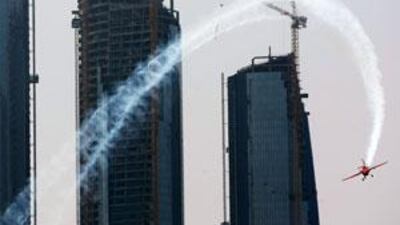Abu Dhabi // Matt Hall admits that his path to becoming a Red Bull Air Race pilot was "a little bit different" than most. Up until last year he was flying F-18s and F-15s and was a "Top Gun" instructor for the Royal Australian Air Force. Today, he will wow crowds on the Corniche as his MXS-R carbon fibre plane twists and turns through pylons just nine metres above the water, at speeds up to 370kph.
"The difference is significant," said Hall, 38. "These planes are more manoeuvrable than a jet fighter. It is all seat-of-your-pants flying." Hall and 14 other pilots will be taking to the air this weekend with one goal in mind - a victory to kick off the 2010 season. To get into the competition, referred to as the "Formula One of the skies", they have each come by a different path. Kirby Chambliss was flying Boeing 737s for Southwest Airlines in the US at 24, while Pete McLeod started off flying float planes in rural Ontario, Canada, in his teens. They have all logged thousands of hours in the sky.
Even after proving his skill at major aerobatic events, a pilot must be invited to qualify for the race. "It takes a huge amount of passion, a huge amount of work," said Alejandro Maclean, 30, from Spain, who is sponsored by The National. Before he started competing in the race in 2003, he captained the Spanish aerobatics team. "Once you are selected as an air race pilot you have to prove that you can be safe and the right type of person to manage the stress," he said.
"There is no feeder series to this," added McLeod, who at 26 is the youngest in the competition. "I had to go out and basically get backing from people to get into this." McLeod represents the changing nature of the race, now in its seventh season. For many of the pilots, aerobatics may have been a hobby while they worked their full-time jobs. But McLeod expects that the competitors in coming years will start younger and devote all their time to the race series.
"The difference now is kids can say, 'There is this thing where guys do it full-time and make a good living, and it's a professional sport'," he said. The pilots are essentially team owners, who, in addition to training, must work with sponsors and make decisions such as whether to invest in a new propeller. "I would love to say all I have to do is just jump in the airplane and fly but that's not the case," said Chambliss, 50. Pilots also spend significant hours in the gym, a necessity to handle the strain of racing.
All the pilots have had scary moments. There have been engine failures and near misses. A system failure at an air show in China had Chambliss hitting the water at 290kph. He suffered fractured ribs and now has a scar across his forehead. "Like anything, there is a level of risk," he said. "Every morning I wake up and ask myself, 'Well is it worth it for me today?' I've always been able to say yes."
@Email:mchung@thenational.ae

